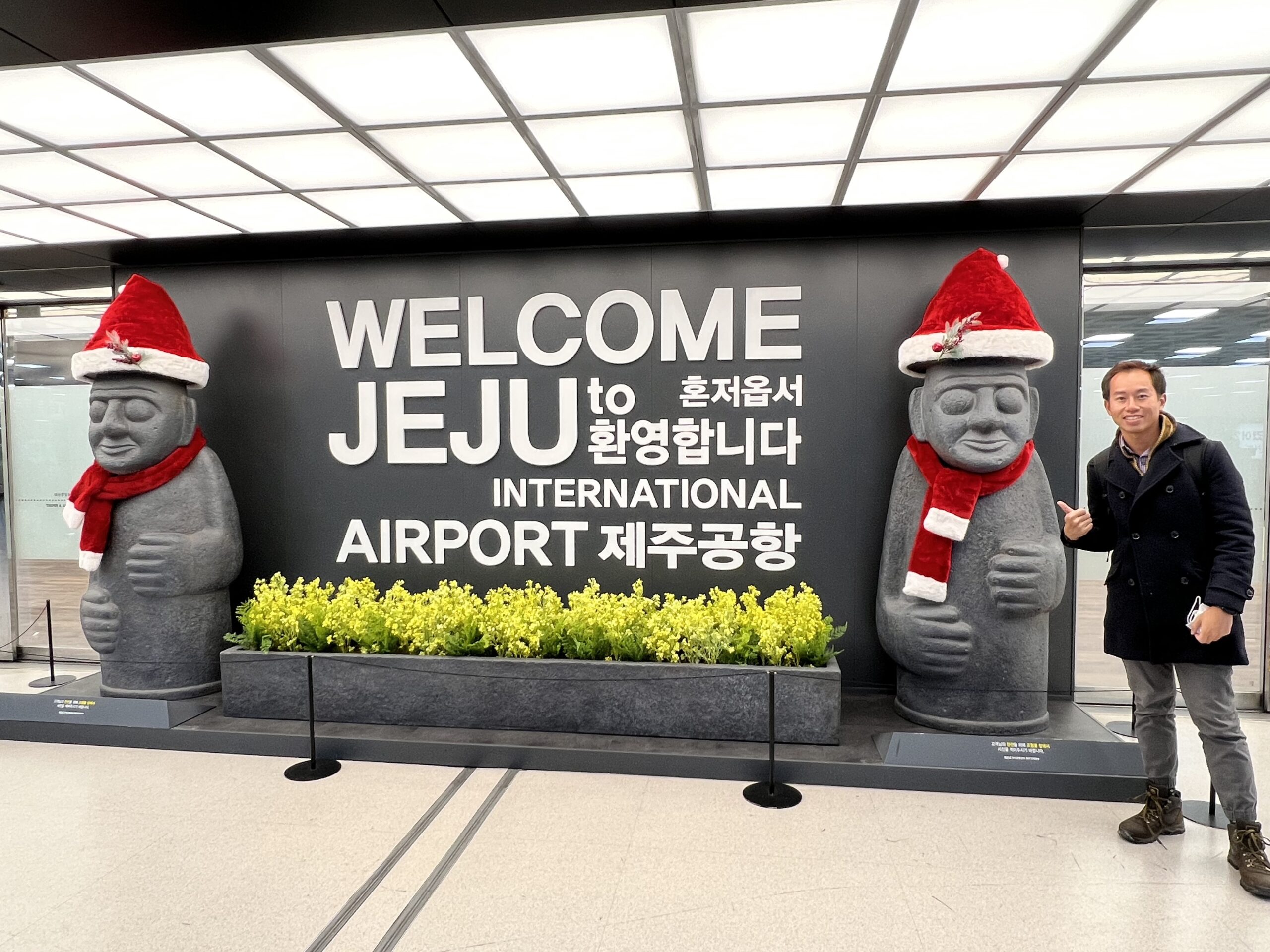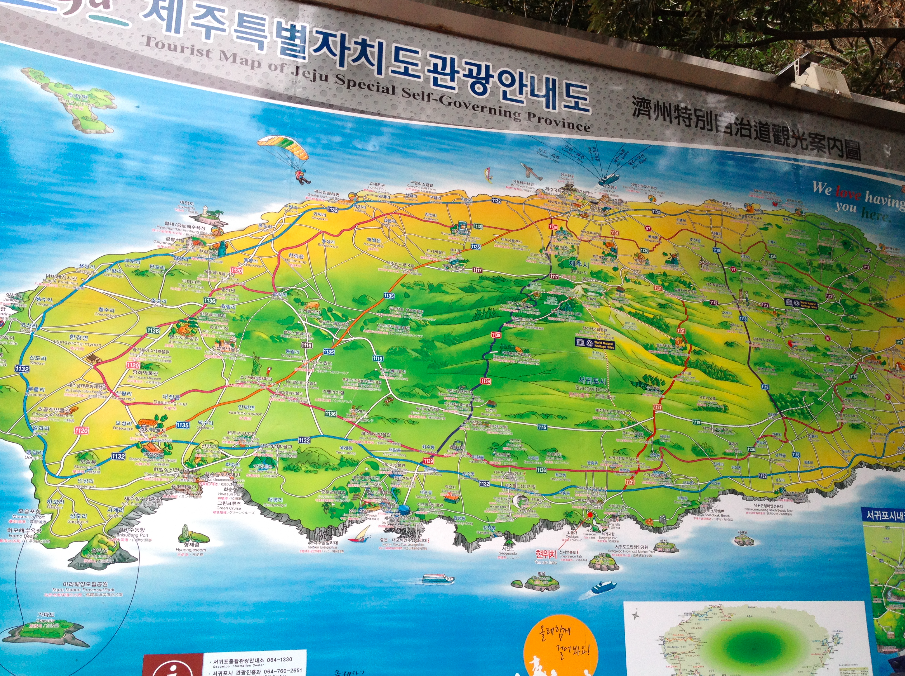

We started off the morning by having a local breakfast near our hotel. We chanced upon this donut shop that sells freshly made donuts and breads. Due to the language barrier and me not understanding all of the Korean that is spoken by the service staff, I only tried certain pastries. We had wanted a corndog, some donuts and dough fritters. In the end, we had a few plain donuts and a breaded croquette. The croquette had chicken filling inside, and was one of the few savoury flavours.

Since the pastries were freshly fried, they tasted so good. We also had an iced coffee and an orange juice to go with our breakfast. We were the only ones eating the shop, while the other customers who dropped by actually took away their food.

Our first activity of the day was hiking, so I wanted to set off early while the sun was still out. The trail that I had chosen – Eorimok trail is estimated to take 5 hours return.

The trail starts at the Eorimok entrance, which is near the Jeju Folk Village. From there, hikers will pass through a dense forest before reaching the first volcanic crater, known as Oreum. The trail then continues along the ridge of the mountain, offering spectacular views of the surrounding countryside and coastline. However, it was not feasible to go on the hike when we arrived, as can be seen by the heavy snow that covered most parts of the trail.

We wanted to venture further past the park gates, but an ahjumma stopped us and tried to explain that it was dangerous for us. We needed crampons for the shoes as it would be slippery. I was disappointed as I had wanted to climb Mt Hallasan but the weather conditions were not permitting.

However, it is important to be prepared for the hike, as the trail can be steep and rocky in some areas. It is recommended to wear sturdy hiking shoes, bring plenty of water and snacks, and be aware of the weather conditions before embarking on the trail.
Since we could not climb up Mount Hallasan, we went to another hiking trail instead. It was about 45 minutes drive away, and is called Saebyeol Oreum. It is one of the 368 oreums (small volcanic cones) that are scattered around Jeju island. Saebyeol Oreum stands at a height of 333 meters and is known for its unique shape and beautiful views.

The name “Saebyeol Oreum” literally means “new star oreum” in Korean. Legend has it that the oreum was formed by a shooting star that fell to the ground and created the volcanic cone. The oreum is also known for its distinctive shape, which looks like a rounded peak with a flat top. We saw many people who were doing the leisurely hike up this hill, some even brought their dog along for some exercise.

At 98m above sea level, this was a simple hike. We could see the coastline of Jeju from the top. The weather was quite foggy, and the winds brought chills, so at the top we quickly took some photos before descending.

At the bottom of the trail, there were some food trucks selling hot food. It was a nice way to indulge in some snacks as a way to reward ourselves for the hard work.

It was almost lunch time and feeling hungry, we headed over to the lunch spot. The seafood restaurant that we wanted to check out was closed the previous day for rest, but today it was open.

Haemultang 해물탕 is a spicy Korean seafood stew made with an assortment of seafood, vegetables, and seasonings. The dish is particularly popular in coastal areas of Korea where fresh seafood is readily available.
The ingredients used in Haemultang can vary depending on the availability of seafood and personal preferences. However, some common ingredients include clams, mussels, shrimp, squid, octopus, crab, and fish. These ingredients are typically combined with a spicy broth made from Korean chili paste, garlic, ginger, and other seasonings. Other ingredients such as tofu, mushrooms, and scallions may also be added for extra flavour and texture. There were countless pieces of abalone in this stew and we ate to our heart’s content. We even added extra ramen noodles as it soaked up the goodness of the broth.

Korean makkeoli is a nice drink to pair with the food. It ia lightly carbonated, milky-coloured beverage that is made from rice, wheat, and water.

After lunch, we had some time and did not want to go back to our hotel so soon, so we decided to take a walk around the area. There were some natural attractions around the area, such as Jeongbang waterfall and Cheonjiyeon waterfall. As I had visited these on a previous trip, so we decided to do other stuff instead.

We walked around Seogwipo Olle Market, an indoor market established in the 1960s with stalls selling produce such as fresh seafood and household goods. It was also a good place to buy some Jeju souvenirs, especially the chocolates, biscuits or wafers made using green tea or Jeju orange.

In addition to food, the market also offers a range of traditional crafts and souvenirs such as Jeju tangerines, pottery, and handcrafted clothing. Many vendors also offer demonstrations and workshops where visitors can learn about the traditional crafts and techniques used to make these products.


We took a short siesta at our hotel before heading out again for dinner. It was at Black Pork Street, a street filled with many restaurants known for their local specialty dish of Jeju black pork.

The array of side dishes was amazing and their kimchi was one of the nicer ones we had tried thus far. Visitors can try a range of dishes, such as grilled pork belly, pork bulgogi, pork stew, and even black pork burgers. The meat is often served with a variety of side dishes, such as kimchi, pickled vegetables, and rice.

We ordered the set for 2, which comes with various cuts of black pork, including a portion of cooked pork belly. The kind staff cooked for us the vegetables and the pork, knowing that we were tourists. We enjoyed this delicious meal of Jeju black pork.


Black Pork Street is a popular destination for tourists who want to experience the unique flavors of Jeju black pork and explore the local food culture of Jeju Island. The street is especially popular at night, when the restaurants and stalls are illuminated with colourful lights, creating a lively and festive atmosphere.


To digest the food after dinner, we took a walk around Jeju city centre, but most of the shops were closed by then. There were some nice canals and lit bridges, but most people were eating and drinking indoors to avoid walking in the cold. What a wonderful day and our tummies were indeed satisfied.

